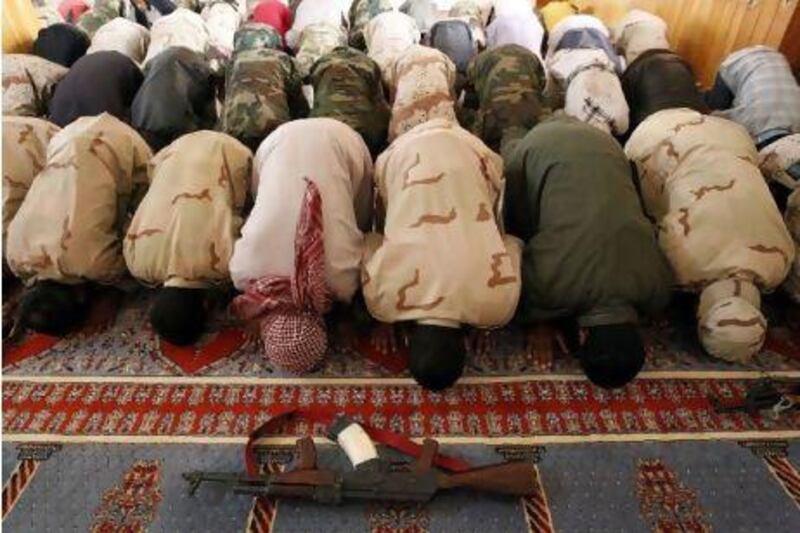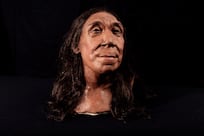Muammar Qaddafi's blood-streaked body was stashed in a commercial freezer at a shopping centre in Misurata yesterday as officials tried to keep his corpse out of the public eye while they figured out where and when to bury the man who held sway over Libya for 42 years.
An Associated Press correspondent saw the body at the shopping centre in Misurata, home of the fighters who on Thursday killed Qaddafi in his hometown of Sirte.
The body, stripped to the waist and wearing beige trousers, was laid on a bloodied mattress on the floor of a room-sized freezer where restaurants and stores in the centre normally keep perishables.
A bullet hole was visible on the left side of his head - with the bullet still lodged in his head, according to the presiding doctor - and in the centre of his chest and stomach. His hair was matted and dried blood streaks his arms and head.
Meanwhile, Nato's top commander said yesterday he will recommend the end of the alliance's seven-month mission in Libya. The American supreme commander of the alliance, Admiral Jim Stavridis, announced on his Facebook page ahead of a meeting of Nato's North Atlantic Council, that the end of the mission marked "a good day for Nato. A great day for the people of Libya."
Nato officials confirmed that the post was authentic.
Outside the Misurata shopping centre, hundreds of civilians jostled to get inside for a peek at the body, shouting "God is great" and "We want to see the dog."
The makeshift provisions for the corpse - at one point it was kept in a private house on Thursday - reflected the disorganisation and confusion that has surrounded Qaddafi's death. His burial had been planned for yesterday, in accordance with Islamic traditions.
But the interim government delayed it, saying the circumstances of his death still had to be determined. Information Minister Mahmoud Shammam also said authorities are "debating right now what the best place is to bury him."
Qaddafi was captured wounded but alive, and there have been contradictory accounts of how he was killed. Some have questioned whether he was shot to death while in custody, something Libyan officials have denied.
New images surfaced of Qaddafi, 69, being taunted and beaten by the fighters who captured him. By authorities' account, at the time the video was taken, Qaddafi would have already suffered the wounds that would kill him about a half-hour later - shots to the head, chest and belly.
In the video, there is blood on Qaddafi's head, but none visible on his chest or belly, and he is talking and rising up.
Rights groups have called for an investigation.
"More details are needed to ascertain whether he was killed in some form of fighting or was executed after his capture," said Rupert Colville, a spokesman for the UN High Commissioner for Human Rights, calling the images of Qaddafi's last moments very disturbing.
One of Qaddafi's sons, Muatassim, also was killed in Sirte, but the fate of Qaddafi's one-time heir apparent Seif Al Islam was unclear. Some Libyan officials said he had been wounded and was being held in a hospital in Zlitan. But Mr Shammam said yesterday that Seif Al Islam's whereabouts were not confirmed, leaving open the possibility he escaped.
In Tripoli, after a night of celebration and gunfire to memorialise Qaddafi's death, citizens awoke in a more reserved mood. For some, the incessant broadcast of Qaddafi's bloodied final moments and corpse on state and international television were enough to turn their stomachs.
Talal Zahlouj, 31, a businessman and social worker walking near Martyrs' mosque, said he felt great happiness that Qaddafi was dead because "he can do no more evil", but the mobile phone videos of the former dictator pleading for mercy were too much.
Still, the abrupt end of Qaddafi's life was good news for Libya's transition to a democracy because loyalists no longer had someone to fight for, he said.
"Now we need to learn to control our anger," Mr Zahlouj said. "Soldiers can put down their weapons and arm themselves with education."
In Martyr's Square, families began amassing by the early afternoon to wave flags and listen to speeches. One soldier, Mohammed Oun, 24, said that he hoped Qaddafi was not given a "nice funeral".
"I want them to erase Qaddafi from earth forever with acid," he said.
In Brussels yesterday, Nato's North Atlantic Council, which comprises envoys from all 28 member countries, was deciding when and how to halt the alliance's Libyan air campaign a day after Qaddafi's death. The decision will depend on Adm Stavridis's recommendation, but will also take into account the wishes of Libya's new government and the United Nations.
Nato's bombing started in March after the UN Security Council authorised countries to protect Libyan civilians from attacks by Qaddafi troops. The UN resolution also imposed a no-fly zone and an arms embargo on Libya, both of which were implemented by Nato and several allies, including the UAE and Qatar.
The operation started dramatically with French and British jets stopping columns of Qaddafi's fighters from taking Benghazi, at the time the main base for the uprising. And it ended with Nato jets reportedly preventing an attempted escaped by Qaddafi in a convoy heading out of Sirte on Thursday.
[ bhope@thenational ]
* With additional reporting by the Associated Press





